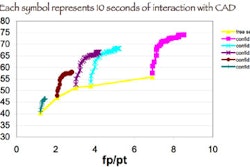(Radiology Review) Korean radiologists found that the peak and net enhancement and maximum enhancement ratio on dynamic CT can be used to predict hilar or mediastinal nodal metastasis in patients with stage T1 lung cancers (≤ 3 cm in diameter). Their research was published in the American Journal of Roentgenology (April 2006, Vol. 186:4, pp. 981-988).
During a two-year period, Dr. Sung Shine Shim and colleagues at the department of radiology and Center for Imaging Science at Samsung Medical Center in Seoul, South Korea, assessed the hemodynamic and conventional morphologic CT findings in 84 patients with stage T1 lung cancer, pre- and postsurgery, using dynamic multidetector-row (MDCT) with enhancement.
Patients had CT scanning using either a four-slice MDCT scanner (LightSpeed QX/I, GE Healthcare, Chalfont St. Giles, U.K.) or a 16-slice MDCT scanner (LightSpeed Ultra or Ultra16 scanner, GE Healthcare). Precontrast imaging included 13 images of the nodule covering "30 mm along the z-axis with 2.5-mm collimation at 120 kVp, 90 mA, 0.8-sec gantry rotation time, and a table speed of 3.75 mm/sec." Postcontrast images included nine series of images obtained at "20-sec intervals for three min after contrast medium injection (120 mL of Iomeron300, Bracco, Milan, Italy) using 120 kVp, 170 mA, 0.8-sec gantry rotation time, and a table speed of 3.75 mm/sec, over eight sec."
To assess the delayed phase of the dynamic study and to reduce radiation, 19 months into the study the researchers changed the postcontrast protocol to imaging at 30, 60, 90, and 120 sec, and at four, five, nine, 12, and 15 min after contrast injection and the mA was reduced to 90mA.
They noted a number of features on CT imaging including "peak enhancement, net enhancement, maximum enhancement ratio, time to peak enhancement, slope of enhancement on dynamic studies, nodule size, presence of tumor necrosis or thickening of bronchovascular bundles, and marginal characteristics," and compared the CT findings with postsurgical histology.
At surgery, 31% of patients had hilar (23%) or mediastinal (15%) nodes, and 7% had both, they said. A peak attenuation of 110 H or greater and a net enhancement of 60 H or greater both predicted nodal metastasis with accuracies of 73%.
The authors concluded that for patients with T1 lung cancer, a peak enhancement on dynamic CT greater than or equal to 110 H or a net enhancement of 60 H or greater suggested the presence of hilar or mediastinal nodal metastasis.
Sung Shine Shim et al
Department of Radiology and Center for Imaging Science, Samsung Medical Center, Sungkyunkwan University School of Medicine, 50, Ilwon-Dong, Kangnam-Ku, Seoul 135-710, Korea
AJR 2006, April; 186:981-988
By Radiology Review
June 20, 2006
Copyright © 2006 AuntMinnie.com



















